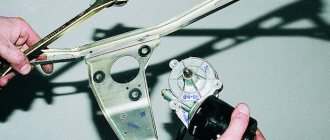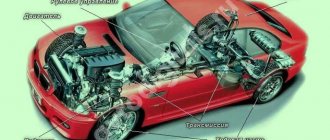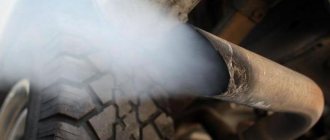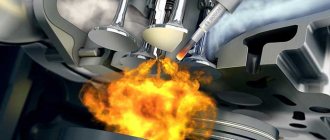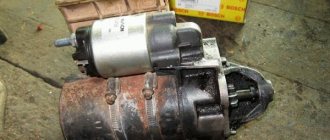Let's start with the fact that over the past ten years, the diesel engine in passenger cars has become a worthy alternative to gasoline counterparts for a number of reasons. At the same time, among the main advantages is significant fuel economy due to better efficiency and other positive qualities of engines of this type.
However, this type of engine is also not without its drawbacks. The main problem of all diesel engines in modern cars without exception is the vulnerability of the sensitive fuel system, as well as the difficulty of cold starting. It should be noted that certain knowledge allows you to avoid a number of similar troubles during the operation of a diesel engine.
In this article we will talk about what a novice diesel driver needs to know about the features of engines of this type, as well as how to start a diesel engine in cold weather and do it correctly with minimal damage to the internal combustion engine and other powertrain systems.
Compression
This is one of the main factors that affects the quality of the launch. Diesel units differ from gasoline units in having higher compression and compression ratio. Let's look at how this factor affects the start of the power unit:
- Compression up to 18. This is a very low figure. In this case, operating a diesel engine in winter is impossible. The car cannot be started even “hot”.
- From 20 to 24. In this situation, the car can be started, but only in a warm box. If it sits outside overnight, it will be extremely difficult to start it.
- About 25. Here the unit can operate at temperatures down to minus 10 degrees Celsius.
- Compression 26-30. The start-up temperature drops to minus 15 degrees.
- 32 and above. This is normal compression that a working diesel car should have. Such a power unit will start without problems at a temperature of minus 20-30 degrees Celsius.
As you can see, the compression ratio significantly affects how the engine performs in winter. The higher it is, the greater the chances of a successful launch.
They sent something wrong
You can increase the freezing point of summer diesel fuel by adding antigel to it. There are many such compounds; they are sold at most gas stations, but it is better for a diesel engine driver to have one with him. And here (attention!) you can’t just splash anti-gel into frozen diesel fuel. More precisely, it is possible, but it will not work. Any instructions say that the additive must be mixed with liquid diesel fuel. In other words, in advance. A life hack from experienced diesel drivers will come in handy: in the enze you need to have not a jar of anti-gel, but a bottle with one and a half liters of kerosene in which the anti-gel has already been diluted. The chances of bringing the contents of the tank to life by pouring such a cocktail into it are much higher. Diesel fuel can also be diluted with simple kerosene in a ratio of 1/10, but, say, in situations where there are signs of freezing of the fuel or a very severe frost is approaching.
It is interesting that, according to Appendix 3 to TR CU 013/2011, which lists the requirements for the characteristics of diesel fuel, the filterability temperature limit (this parameter actually determines the temperature limit of its use) for summer diesel fuel is not determined at all. For off-season in all countries of the Customs Union this parameter is -15, and for winter -20 degrees Celsius. But... not in Kazakhstan. For Kazakhstan these are -5 and -15, respectively.
How to check the value?
To do this, use a device - a compression meter. But the measurement procedure is slightly different from that performed on gasoline engines. The compression gauge is screwed into the injector installation location.
Next, the engine is started. In this case, you do not need to press the accelerator pedal. Three to four revolutions of the crankshaft are enough for the device to “grab” the maximum readings. If the compression is below 17, the engine may not start at all. Normal values should be around 30, but not less than 24 revolutions. It is worth checking the engine when the mileage is more than one hundred thousand kilometers, as well as on the eve of the winter season. By fixing the breakdown in advance, you will not have to deal with how to start a diesel car in cold weather. To increase compression, repair of the cylinder-piston group is required. However, this procedure is already performed by specialists.
Why you can’t start a diesel engine in winter “from a pusher”
This method is undesirable not only in the cold season, but also in the summer. Modern diesel passenger cars do not handle jerks well. And in a frozen state they are even more sensitive to mechanical damage. When using this method, there is a high risk of bending the valve stems or tearing the actuator. As a result, expensive repairs will be required.
To avoid difficulties with starting a diesel engine in cold weather, it is recommended to leave the car overnight in a warm parking lot and be sure to monitor the condition of the spark plugs and the battery charge level. Paying close attention to your car will help you avoid most problems.
Battery
A fresh battery is a guarantee of a successful start at any time. And it doesn’t matter whether you start the engine “hot” or “cold”. A good charge will ensure good rotation of the crankshaft, and as a result, a quick start of the power unit. The battery life is three to five years. It is worth noting that a diesel unit requires more energy to start than a gasoline unit (even if the compared engines have the same number and arrangement of cylinders). Before the start of winter, you should check the electrolyte level. If the liquid has boiled away in a small volume, it is recommended to replenish it with distilled water. It is strictly forbidden to pour regular water from the tap. Also check the quality of connections at the terminals. Sometimes they oxidize, as shown in the photo below:
In this case, it is recommended to clean them in order to ensure a high-quality connection of the conductors. To do this, remove the terminal and take coarse sandpaper in your hands. Also check the contacts that go to the starter. If necessary, they are also cleaned of dirt and deposits.
Additional equipment
You can install many different heaters on a diesel, as well as a gasoline, car. For diesel engines, heating the fuel intake, fuel line, fuel filter, flow-through fuel heaters, as well as various universal “boilers” for antifreeze operating from a household electrical network and autonomous heaters are relevant. Experienced installers of such systems usually have recommended solutions depending on the vehicle model. And the apotheosis of preparation for winter can be the installation of a gasoline autonomous heater on a diesel engine, the kit of which will include an additional tank for gasoline, a filler neck, pipelines or the need to make a tank from stainless steel, as well as, in especially severe cases, inserting a second fuel hatch into the fender of the car . This is a difficult and expensive path, which, however, is followed by other SUV owners. But then they can consider themselves ready for anything.
But additional electrical equipment has one drawback, which refers us to point two - the risk of getting a warmed-up car, but with a completely drained battery. And then another battery and a separate charging system for it are added to the list of necessary items. True, this is a completely prohibitive level of preparation. Although in such a car you can go off-grid even for the whole winter, and cut the summer diesel fuel into bricks and put it in a trailer.
Filters
If your diesel engine won't start, the problem may be due to accumulated "sludge" in the fuel filter. Dirty particles interfere with the normal supply of fuel. The service life of the fine filter is 10 thousand kilometers. As for the coarse cleaning element, you can simply blow it out with a compressor and install it back. The main part of the dirt accumulates in the second filter. The fine cleaning element retains particles up to 10 microns in size. It itself is porous paper placed in a metal case.
If the diesel engine does not start, it means that this element is dirty and requires replacement. When preparing your car for winter, don't forget about the air filter. Since the engine requires not only fuel, but also oxygen, the condition of this cleaning element directly affects the quality of operation and starting of the engine. Advice from experienced drivers says that this filter should be changed as often as possible (but not later than 10 thousand kilometers). Its service life is especially reduced when used in rough terrain, where instead of asphalt there is slag and primer.
Scary?
We unwittingly collected almost all the horror stories for diesel drivers. But if you look at it, the main recommendations boil down to keeping the car in good working order, performing all routine maintenance on time and refueling with high-quality fuel. With the latter, of course, sometimes difficulties arise. And even taking this into account, many car owners, when preparing their cars for winter, rarely move beyond the fifth point. Still scared? Then pay attention to the item “additional equipment”. By the way, we plan to develop the topic of additional equipment on the pages of our publication.
Glow plugs
Gasoline engines use spark plugs to ignite the mixture. A diesel engine is designed differently. To start and operate it, no additional spark is required - the mixture ignites due to a high degree of compression. But modern manufacturers equip diesel engines with auxiliary elements. Among them is a glow plug. It heats the diesel fuel to make the launch more successful.
This is especially true in winter. How to start a diesel engine correctly in severe frost? To do this, you need to wait until the spark plug heats the fuel. Turn the key to the third position. The indicator light on the instrument panel will light up. It is usually red or yellow. After a few seconds it will go out. As soon as it stops burning, start the engine. This way, you allow more time for the spark plug to heat the fuel better.
What absolutely should not be done
Some drivers consider starting a sleeping engine by towing. We do not recommend doing this as it is very risky. With such a start, the acceleration angle of the rotating flywheel will be greater than with a normal start using a starter.
In modern passenger cars, the timing belt drive will jump forward after several teeth or simply break. If the timing chain is made of metal, it can stretch. Be that as it may, when starting the engine by towing, there is a great possibility of disrupting the correct arrangement of the elements of the gas distribution mechanism, pistons and cylinders. Repairing pistons and valves can cost you a fortune later on.
Advice: if towing is the only and inevitable option, then engage a higher gear, third or fourth. In this case, at least to some extent, increased shock loads on timing parts can be avoided.
How to start a diesel engine in cold weather? Ether in aerosol
Surely you have heard about such means as “easy start”. These products come in small aerosol cans. They are useful because they can start a diesel engine even in extreme conditions. The product contains flammable substances. Due to them, the engine starts “easy”. The mixture begins to burn earlier - the chances of a successful start increase several times. But it is worth remembering that in large quantities, flammable substances harm the diesel engine. Therefore, this product should be used only in emergency situations.
How to start a diesel engine in cold weather using “easy start”? To do this, unscrew the air filter housing, or better yet, remove the pipe. We begin to spray the composition directly into it. At this time, the assistant turns the starter. The engine will start easily.
And candles...
Where do spark plugs come from in a diesel car? They are there. These are glow plugs that heat the combustion chambers before starting the engine. Actually, if they work, then there is no need to change them, but if not, it is critically important to replace them. Why do they get so much attention, since it’s generally logical to replace broken parts? Because in the summer, faulty spark plugs may not be noticeable, but during the first cold weather it will cause the engine to not start. So we check if everything is okay with them.
Dilute the fuel
Everyone knows that diesel, unlike gasoline, has two grades - summer and winter. The so-called Arctic fuel does not always appear at gas stations on time. Cold snaps occur. Then the question arises of how to start a diesel engine in winter on summer diesel fuel. Since its crystallization temperature is an order of magnitude higher, it freezes more easily. At minus 10 degrees it turns into paraffin.
It is simply impossible to start the engine with such fuel. What to do in such a situation? To do this, we will need to dilute the fuel in a tank with a special “winter” additive. The same is added at gas stations (in the same “summer fuel”), so this product should not be considered foreign and harmful to a diesel unit. It is recommended to pour the product in advance (for example, overnight). In the morning you will successfully start the engine on summer fuel. The product is inexpensive - about 400 rubles for a 500-ml bottle. But there are cases when diesel fuel crystallizes in the filters themselves.
And no additive will help here. How to start a diesel engine in cold weather? For this, third-party elements are used. Simply put, the filter is heated with a gas or kerosene burner. No need to worry - diesel fuel will not ignite from such a fire. The main thing is not to get on plastic elements that can melt. This is the surest way to start the engine in any cold weather.
What can be replaced
For a gasoline engine, it is enough to inject 1 cubic meter of 95 gasoline for easy starting. But this will not help for a diesel engine. What can replace such a launch? It is recommended to use a silicone lubricant spray, which is usually used to treat plastic or rubber elements in the car interior. It contains flammable, rapidly evaporating substances and silicone. Suitable for one-time use in a critical situation. However, when the components included in its composition burn, solid substances are obtained that act as an abrasive, causing scuffing of the metal. Therefore, its frequent use is extremely harmful to engine parts.
Useful tips
Experienced drivers advise using kerosene as an additive. It is diluted in a ratio of one to ten. Kerosene is not harmful to a diesel engine. And the effect is the same as that of specialized additives. The product will make diesel fuel more liquid, and excess substances will evaporate through the crankcase ventilation system. If you don’t have a burner or kerosene with additives at hand, you can heat the filter using improvised methods. For example, boiling water from a kettle, or a hairdryer. This is especially true for cars with plastic fuel lines. Under the influence of high temperatures, the diesel fuel will become less thick, and you will be able to successfully start the car.
Oil viscosity
Oil intended for summer is thicker than winter oil. If you leave such oil for the winter, there is a high probability that problems with your car will arise in cold weather. At very low temperatures, summer oil thickens significantly and becomes like grease.
In order for the crankshaft to turn in such an environment, the starter will require additional effort. That's why there is a special winter oil for winter. Remaining liquid, it retains its properties and promotes good sliding of parts.
In the European Union, America and Japan, SAE oil is classified by type.
- Summer oil
- Winter oil
- All-season oil
In winter, oils of 0W, 5W, 10W, 15W, 20W, 25W are used. The numbers here show the specific temperature at which the lubricant is used. The smaller they are, the lower the temperature outside the vehicle being used can be.
Starting a car with automatic transmission
An automatic transmission has a torque converter in its design. It works thanks to the oil that is inside. In winter it also thickens. On cars with manual transmission, to disconnect the transmission from the engine, just press the clutch pedal. On an automatic, the starter has to waste energy to turn the flywheel and gearbox shaft, since the unit does not completely disengage.
This makes starting the engine difficult. To successfully start the engine in winter, you need to change the automatic transmission oil more often. The cleaner it is, the easier it will be for the engine in winter. As a last resort, warm it up with a hairdryer, but this applies to cases where the temperature is far below minus 30.
Let's warm ourselves up
A felt blanket or a car blanket, any kind, even the standard plastic protection of the engine compartment from below and the notorious cardboard in front of the radiator, is a must-have. On other cars, without all this, the engine may reach operating temperature about twenty minutes after the start of the trip. Well, the stove won’t start heating up soon either.
Service
The specifics of operating diesel engines imply scrupulous compliance with all manufacturer's requirements, any violation of which may ultimately lead to the need for expensive repairs. Recommendations common to all power plants of this type include:
- Timely replacement and quality control of oil. Experts advise carrying out this procedure even more often than the service interval prescribed in the manual. This recommendation is due to the unstable sulfur characteristics of Russian diesel fuel. As a conditional interval, you can focus on a mileage of 7000 km? 7500 km.
- Timely replacement of the timing belt. In this case, it is recommended to follow the same principle as when changing the oil. For many engines, the permissible belt mileage reaches 100,000 km, but it must be taken into account that we are talking about practically sterile conditions, which are fundamentally unattainable on domestic roads. The breakage of a belt that has worn out prematurely always means destruction of the cylinder head, the repair or replacement of which costs a significant amount.
- Monitoring the cleanliness of the fuel system. It is recommended to replace the filter at least every 10,000 km, and to regularly drain the sediment that accumulates in the sump from the filter itself. It is advisable to wash the fuel tank twice a year, removing it from the car. Failure to comply with these requirements may result in failure of the injectors and fuel pump.
Advantages
Diesel fuel power units are characterized by a number of general advantages.
- Economical. The efficiency of such engines is 40% and can reach 50% with a supercharging system.
- Power. When operating diesel engines with a turbine, there is no classic pronounced turbo lag, and all the torque becomes available almost from the lowest revs.
- Reliability. The mileage of diesel power units is up to 700,000 km.
- Environmentally friendly. The use of EGR technology and a significantly lower volume of CO in the exhaust gases can significantly reduce the negative impact on the environment.
Electrical preheating
Some cars are equipped with an electric heating system.
It comes in two types.
- The heating element is installed in the cylinder block.
- The heating element is included in the small circuit of the cooling system through hoses, but is installed as a separate unit.
If you have access to an outlet, this is one of the most gentle and 100% successful launch options.



